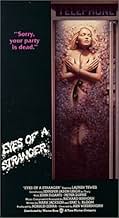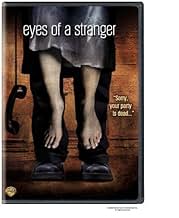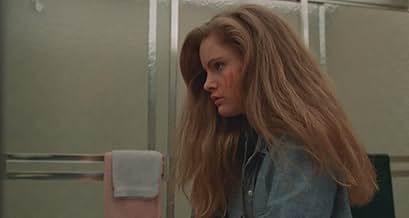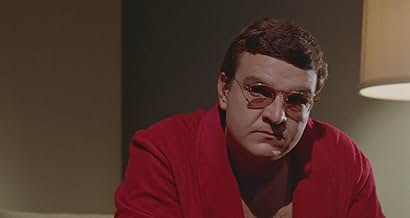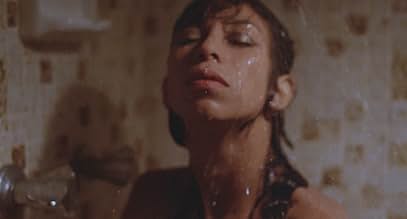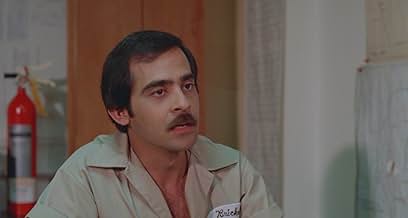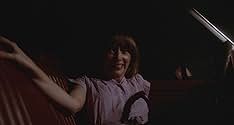Um jornalista suspeita que um vizinho assustador, que mora no prédio em frente ao seu, é um assassino em série que aterroriza a área de Miami.Um jornalista suspeita que um vizinho assustador, que mora no prédio em frente ao seu, é um assassino em série que aterroriza a área de Miami.Um jornalista suspeita que um vizinho assustador, que mora no prédio em frente ao seu, é um assassino em série que aterroriza a área de Miami.
- David
- (as Peter DuPré)
- Dr. Bob
- (as Bob Small)
- Jimmy
- (as José Bahamande)
- Woman in Car
- (as Rhonda Flynn)
- Direção
- Roteiristas
- Elenco e equipe completos
- Produção, bilheteria e muito mais no IMDbPro
Enredo
Você sabia?
- CuriosidadesOriginally conceived and shot as a more straightforward thriller, partway through production it was decided to embrace the then-current slasher genre and introduce more gore and violence.
- Erros de gravaçãoDuring one of the last scenes of the movie, a man rips Jennifer's top completely from front but during next few seconds her top is intact but later on when she goes to bathroom her top is ripped again.
- Citações
[first lines]
TV Reporter: Police say the body was found early this morning by a wildlife photographer in a mangrove swamp off Key Biscayne. The victim's clothes were in disarray, and police believe she may have been the victim of an assault. This is possibly the third rape/murder in as many weeks. However, police are not willing to say the murders are connected.
- Versões alternativasAlthough the print submitted was the heavily edited U.S R-rated one, UK cinema and video versions were cut by a further 1 min 25 secs by the BBFC with edits made to shots of nudity and heavy cuts to the belt strangulation scene. While the 18-rated version of the film was the BBFC-approved cut version, Warner did in fact issue an uncut version rated X prior to this in the early 1980s.
I'd recommend "Eyes of a Stranger", a nearly forgotten slasher-style suspense thriller from 1980 that has the distinction of being the film debut of Jennifer Jason Leigh (who gives a terrific performance as a blind, deaf and mute teenager who must fight off an assailant inside her apartment like Audrey Hepburn in "Wait Until Dark"), and which also features gore effects by the legendary Tom Savini.
Set in and around Miami (just like director Ken Wiederhorn's earlier Nazi zombie feature "Shock Waves" -- clips of which appear on the television set during the first murder scene), "Eyes of a Stranger" is basically an update of "Rear Window" embellished with references to a number of other suspense thrillers. The opening scene, in which the nude body of a murder victim is discovered immersed in a mangrove swamp, is a direct nod to the opening of Hitchcock's "Frenzy"; and a much later scene, in which the killer furtively watches a striptease dancer undress before (it is implied) he attacks her in a shower stall, is a clear homage to "Psycho".
"Eyes of a Stranger" starts off with the classic slasher premise established by "Black Christmas": the creepy serial killer who stalks and terrorizes young women with harassing phone calls before he finishes them off in person. Despite a trail of bodies with a common M. O., there is no hint of any police investigation in the movie. Likewise, none of the women have any male protectors who can save them from the killer, and the ones who try just end up as hapless collateral damage -- including one particularly memorable (and gruesomely funny) image of a severed head in a fish tank, which is itself a direct steal from the then-contemporary 1980 slasher thriller "He Knows You're Alone".
In terms of its storytelling, "Eyes of a Stranger" is split into two distinct halves: in latter part, the movie deliberately alters and undermines its earlier narrative focus and becomes a different sort of genre picture than the standard slasher exploitation fare, as the killer becomes the person who is spied upon and harassed in his apartment by an inquisitive neighbor (again, think "Rear Window"). By this point, we see that the killer, as ruthless and determined as he is, is not some indestructible bogeyman like Michael Myers, Jason Vorhees, or the later Freddy Krueger. Instead, he is revealed to be quite fallible and vulnerable, especially when confronted by the female protagonist (played by Lauren Tewes), who, earlier in the movie, is seen risking her life by breaking into his apartment to search for clues (just like Grace Kelly did in "Rear Window"). For this reason, "Eyes of a Stranger" has been considered a quasi-feminist "rape-revenge" vigilante film (in his book, "Hollywood from Vietnam to Reagan ...and Beyond", the late British critic Robin Wood wrote an especially spirited defense of this movie along those particular lines).
The first half of "Eyes of a Stranger" generally conforms to all the familiar narrative clichés of the slasher genre by presenting us with the image of a serial murderer who appears to be endowed with the superhuman powers of an omniscient and ubiquitous bogeyman. This hackneyed "invincible killer" trope is an unmistakable feature of the first two murder scenes, where the killer's presence is only hinted at metonymically -- as a disembodied voice on the phone, as a masked silhouette lurking in the darkness, or in closeup shots of his feet following his prey or his hands brandishing a weapon. Here, we see the killer stalking and entrapping his victims with all the practiced stealth and finesse of a ninja assassin -- an extraordinary ability which the movie doesn't bother to explain or justify in any plausible way. As we watch these scenes play out, our suspension of disbelief waxes and wanes and we are left wondering to ourselves: how did he get inside that apartment or sneak into the back of that woman's car, or obtain the emergency phone number for that elevator?
However, about halfway through "Eyes of a Stranger", the movie's contrived illusion of an omnipotent killer endowed with superhuman competence is quickly and permanently abolished. This demystification first occurs during a scene where his tires get stuck in the mud while disposing of his latest victim, and he is forced to dispatch two potential witnesses who are making out in the car next to him. Here we begin to see that this killer is hardly very subtle or discreet in the way he goes about his business. Careless and impulsive, he doesn't seem to have that much common sense, let alone any sophisticated forensic awareness, about escaping detection or (literally) covering his tracks. All throughout the movie, we see him repeatedly stalk and attack women in apartment complexes and car parks -- semi-public spaces where his suspicious comings and goings could easily be noticed (and eventually are). In fact, he is so sloppy and disorganized that it seems the temporary success of his killing spree can only be attributed to dumb luck and a curious absence of any police vigilance and deterrence. By this point, we come to realize that under normal circumstances, he could be caught in the act at any time.
It doesn't take long before the killer's luck finally does run out, and when we at last see him as he really is, his pale expressionless face, portly frame and slouching gait expose him as the very image of a rather depressing ungainliness and ordinariness (much like Raymond Burr's pitifully inept and desperate uxoricide in "Rear Window"). In the end, there is nothing the least bit impressive, clever, seductive, mysterious or otherworldly about this killer. If anything, he appears dull, clumsy, slovenly, unattractive and very, very common. Indeed, it is in this way that the more fanciful and dubious conceits of the genre are deliberately undermined, and any semblance of the sadistic relish and artfully evinced horror atmosphere that slasher movie enthusiasts may have once admired about the killer during the staging of his earlier murders is rapidly and purposefully dissipated.
This undermining of the "invincible killer" trope is most clearly demonstrated during a brief scene toward the end of the movie in which no physical violence occurs at all. Here, we see the killer stripped of any theatrical pretense of devilish glamour or mystery -- his pudgy plain face and flabby middle-aged physique now fully visible in clear light -- as he casually torments a blind teenager by removing familiar objects from her reach on a kitchen counter. I imagine that the banal viciousness and petty psychological cruelty of this otherwise harmless act was more upsetting and disturbing for most viewers than any of the physically gruesome murder scenes in this movie (which are, of course, standard for the genre and are, alas, to be expected).
As the late Robin Wood astutely observed, the culmination of this studied demystification of the mad-slasher bogeyman occurs in the last reel of "Eyes of a Stranger", when the killer suddenly meets his violent and ignominious end in a shower stall (an inversion of the earlier "Psycho" reference), and the final lingering image of his broken glasses perched crookedly on his bloated lifeless face, with eyes now permanently shut from a fatal bullet wound in his forehead, seems not only a stunning reversal of fortune but a moralistic indictment of anyone in the audience who took a portion of vicarious pleasure in the movie's preceding mayhem.
- redskiesmaxx
- 29 de dez. de 2020
- Link permanente
Principais escolhas
- How long is Eyes of a Stranger?Fornecido pela Alexa
Detalhes
Bilheteria
- Orçamento
- US$ 800.000 (estimativa)
- Faturamento bruto nos EUA e Canadá
- US$ 1.118.634
- Fim de semana de estreia nos EUA e Canadá
- US$ 546.724
- 29 de mar. de 1981
- Faturamento bruto mundial
- US$ 1.118.634
Contribua para esta página



